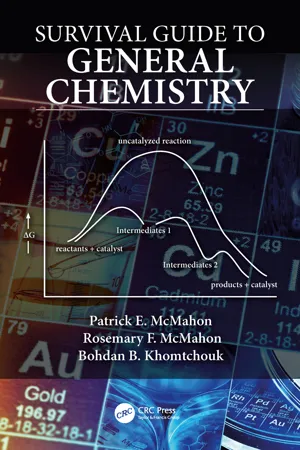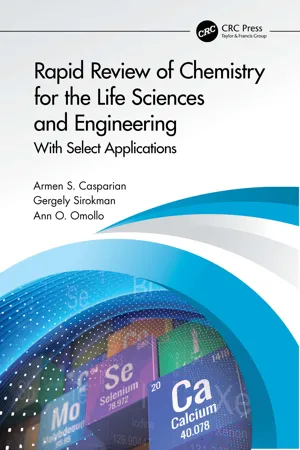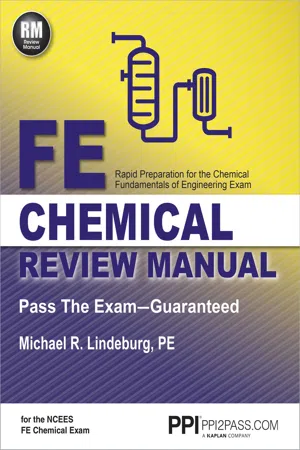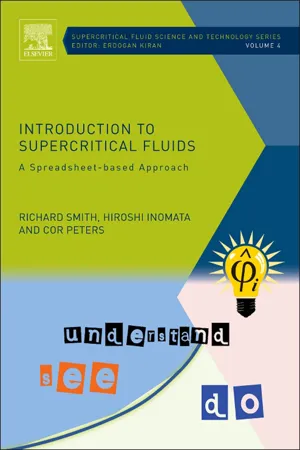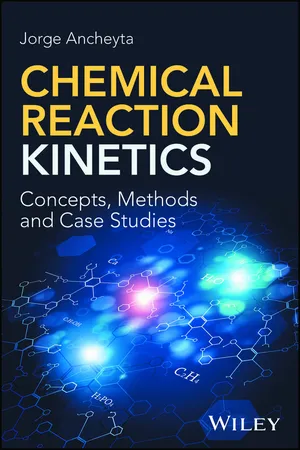Chemistry
Reaction Quotient
The reaction quotient is a measure of the relative concentrations of products and reactants in a chemical reaction at any given time. It is calculated using the same formula as the equilibrium constant, but it is used to determine whether a reaction is at equilibrium or not. Comparing the reaction quotient to the equilibrium constant helps predict the direction a reaction will proceed.
Written by Perlego with AI-assistance
Related key terms
Related key terms
1 of 4
Related key terms
1 of 3
7 Key excerpts on "Reaction Quotient"
- eBook - ePub
- Patrick E. McMahon, Rosemary McMahon, Bohdan Khomtchouk(Authors)
- 2019(Publication Date)
- CRC Press(Publisher)
23 General Techniques for Solving Equilibrium ProblemsI CONCENTRATION QUOTIENT AND EQUILIBRIUM EXPRESSION Each reversible reaction has two sets of molecules: the set of molecules on the left represents reactants in the forward reaction and products in the reverse reaction; the set of molecules on the right represents products in the forward reaction and reactants in the reverse reaction.A, B, C, D = general reactants and products; a, b, c, d = stoichiometric coefficients of A, B, C, D respectively in the balanced equation.Viewed from the perspective of the forward reaction, the reactants are A and B; the products are C and D. A specific ratio of products to reactants, termed the concentration quotient (symbol = Q), is defined for any actual values for concentrations of components at any point in a reversible reaction. The form of the ratio expression uses the specific concentration of each species, usually as molarity (M) or gas partial pressure (Pgas ), raised to the power of its coefficient in the balanced equation:Q=( forward reaction )α[C] c[D] d[A] a[B] b[products] [reactants]The rate of a reaction is proportional to the concentrations of the molecules reacting (Chapter 22 ). The rate of the forward reaction is proportional to the concentrations of the reactants A and B; the rate of the reverse reaction is proportional to the concentrations of the products C and D.rate(forward) = k(forward) [A]x [B]y rate(reverse) = k(reverse) [C]x [D]yViewed from the forward direction, as the reaction proceeds, the concentrations of the reactants [A] and [B] decrease; the rate of the forward reaction correspondingly decreases. Concurrently, the concentrations of the products [C] and [D] increase, and the rate of the reverse reaction correspondingly increases. Regardless of the numerical values of the forward and reverse rate constants, there must come a point in the progress of the reaction when the net forward and net reverse rates are equal. (At the extreme, as concentration of reactants approach zero, the forward rate approaches zero.) - eBook - ePub
Rapid Review of Chemistry for the Life Sciences and Engineering
With Select Applications
- Armen S. Casparian, Gergely Sirokman, Ann Omollo(Authors)
- 2021(Publication Date)
- CRC Press(Publisher)
4 Chemical EquilibriumDOI: 10.1201/9781003092759-44.1 Basic Concept
Reaction equations describe substances, called reactants, which when put together react and produce other different substances, called products. It may appear as if only products remain after the reaction is finished. In reality, many reactions do not go to completion, even if the reactants are present in stoichiometric ratios or amounts. Rather, they reach a condition known as equilibrium, denoted by double, reversible arrows in the reaction equation. Equilibrium means that there is a balance between the reactant side and the product side, or simply between the reactants and the products, and that the reaction is reversible. The chemistry of many air pollutants falls and many bodily functions under the heading of equilibrium reactions. The equilibrium condition is dynamic, not static, allowing microscopic changes in reactant and product concentrations to take place, such that no net change in reactant or product concentrations occurs, provided that no external stresses are applied. At any given time, all species in the reaction equation—reactants and products—are present at equilibrium in varying amounts. The relationship among these varying amounts can be described by a mathematical formula known as the equilibrium constant expression or simply the equilibrium expression. The equilibrium expression is set equal to an equilibrium constant symbolized by Kc .An equilibrium reaction can be generally represented as follows:a A + b B ⇋ g G + h H(4.1)The Kc expression can then be expressed as follows:(4.2)K c=[ G ]g[ H ]h[ A ]a[ B ]bwhere a, b, g, and h represent the stoichiometric coefficients in the balanced reaction, and the brackets [ ] indicate molar concentrations. The simplest interpretation of Kc is that it is a measure of the extent to which a reaction goes toward completion, i.e., a reaction where the product side is favored. The meaning of Kc - No longer available |Learn more
- Steven Boone, Drew H. Wolfe(Authors)
- 2011(Publication Date)
- Collins Reference(Publisher)
c . The equilibrium constant equals the product of the molar concentrations of the products, each raised to the power that corresponds to their coefficients in the balanced equation, divided by the product of the molar concentrations of the reactants, each raised to the power corresponding to their coefficients. Equilibria that have reactants and products in more than one phase are heterogeneous equilibria, and those in which all substances in one phase are homogeneous equilibria.If the value of the equilibrium constant is greater than one (K c > 1), the magnitude of the numerator (products) of the equilibrium expression is larger than that of those of the reactants. If the value of K c is less than one (K < 1), the equilibrium concentrations of the reactants are usually greater than those of the products.Equilibrium constants for gas-phase equilibria are often expressed in terms of their partial pressures. This is known as the K p equilibrium constant. The following equation shows the relationship of K p to K c .K p = K c (RT) ΔnEquilibrium constants are obtained by measuring the equilibrium concentrations or partial pressures of each component of an equilibrium mixture and substituting these values into the equilibrium expression.Before a system reaches equilibrium, the concentrations or partial pressures are expressed in terms of the Reaction Quotient, Q . The expression for Q is in the same form as that of K . The value of Q is used to determine the direction from which an equilibrium develops. Concentration, pressure, volume, and temperature changes affect the concentrations of the components of a chemical equilibrium. Their effects may be predicted by the application of Le Chatelier’s Principle, which states that equilibrium systems tend to absorb any changes that may occur in such a way to reduce the change and return to a state of equilibrium.Test Yourself1. Write the equilibrium expression for the following. - eBook - ePub
- Jeffrey Gaffney, Nancy Marley(Authors)
- 2017(Publication Date)
- Elsevier(Publisher)
7.2, when the reactants of a reversible reaction are first combined, the forward reaction occurs rapidly increasing the concentrations of the products and decreasing the concentrations of the reactants. As the reaction proceeds and the concentration of products increases, the forward reaction slows and the reverse reaction begins to occur. After some time, an equilibrium is reached where the concentrations of reactants and products do not change with time and the forward and reverse reaction rates are equal. This is known as a dynamic equilibrium because, although forward and reverse reactions still occur, the rate of the forward reaction equals the rate of the reverse reaction. So, the ratio of concentrations of the products to the concentrations of the reactants remains constant, although the reaction is constantly proceeding in both directions. Fig. 7.2 A reversible chemical reaction reaches dynamic equilibrium when the rate of the forward and reverse reactions are equal (left) and the concentrations of reactants and products do not change with time (right). 7.2 The Equilibrium Constant Since the concentrations of reactants and products of a reversible reaction at equilibrium are constant, an expression can be written for an equilibrium constant (K eq) that describes the concentrations of the products and reactants at equilibrium. For the generic reversible reaction (3) at equilibrium, the equilibrium constant expression is; K eq = C c D d A a B b (4) As with the acid ionization constants described in Section 5.2, the equilibrium constant for a reversible reaction is expressed as the ratio of the equilibrium concentrations of the products in the numerator to the equilibrium concentrations of the reactants in the denominator. The superscript letters are the stoichiometric coefficients of the reactants and products in the balanced chemical equation - eBook - ePub
- Michael R. Lindeburg(Author)
- 2016(Publication Date)
- PPI, a Kaplan Company(Publisher)
11The second form ofEq. 52.8relates the equilibrium constant to the total pressure, .Equation 52.9relates the partial pressure to the actual fugacity.12Equation 52.10: Variation of Equilibrium Constant with Temperature52.10AsEq. 52.3shows, the equilibrium constant is related to the equation of state. Since the equation of state contains a temperature term, anything derived from the equation of state depends on temperature. The equilibrium constant’s dependency on temperature is given byEq. 52.10, where ΔH 0 is the standard molar enthalpy of reaction.13 Although the equilibrium constant varies considerably with temperature, ΔH 0 is reasonably insensitive to the temperature. When integrated,Eq. 52.10is essentially the same as the Clausius-Clapeyron equation (and the Arrhenius equation for the temperature dependence of reaction rate constants), and is known as the van’t Hoff equation .4. Reaction RateThe rate of reaction (also known as the reaction velocity ), r A , of component A in a chemical reaction is the rate at which the concentration of component A changes. A reactant that decreases in concentration with time has a negative reaction rate (i.e., r A - eBook - ePub
Introduction to Supercritical Fluids
A Spreadsheet-based Approach
- Richard Smith, Hiroshi Inomata, Cor Peters(Authors)
- 2013(Publication Date)
- Elsevier Science(Publisher)
Chapter 9Chemical Equilibria and Reaction Kinetics
Richard Smith, Cor Peters and Hiroshi Inomata Logic will get you from A to B. Imagination will take you everywhere. Albert Einstein (1879–1955)Tip Box#1 Chapter objectives(1) to review key concepts in thermochemistry (2) to introduce methods for analyzing chemical equilibria (3) to show the effect of nonidealities on “real world” chemical equilibria (4) to introduce thermodynamic analysis of chemical reactors (5) to show how reaction kinetics are used to model reaction pathways9.1 Overview
Chemical equilibria gives one the composition of a reaction system in its most stable state, whereas reaction kinetics gives one the rate at which the chemical species are transformed from their initial state to a final state. Analysis of chemical equilibria helps one to understand the limits of a reaction according to its thermodynamics and the given reaction conditions. Analysis of reaction kinetics helps one to understand how long it will take to make the transformation in reality. Detailed development of chemical equilibria theory is given in many excellent undergraduate textbooks in chemical thermodynamics [CT1 –CT3] and chemical reactions [CT4] .With any type of chemical reaction or process, energy transfer occurs and this is the basis of thermochemistry. The energy transfer of a reaction is described by thermochemical equations, which are balanced stoichiometric equations for the reactant and product chemical compounds. Thermochemical equations are written in terms of the moles of each chemical compound, for example:(9.1)The a and b are stoichiometric coefficients that represent the moles of reactant chemical compounds A and B , respectively, required to form c moles of product chemical compound C . When changes in properties are calculated by treating Eq. (9.1) as a mathematical equation, by convention, the stoichiometric coefficients are positive (+) for products and negative (−) for reactants . Thus, the change in enthalpy of Eq. (9.1) - eBook - ePub
Chemical Reaction Kinetics
Concepts, Methods and Case Studies
- Jorge Ancheyta(Author)
- 2017(Publication Date)
- Wiley(Publisher)
1 Fundamentals of Chemical Reaction KineticsIn homogeneous reacting systems, all the reactants and products are in the same phase. If the reaction involves a catalyst, it is also in the same phase. To determine the rates of reaction, experimental information is needed, which is generated by using properly designed small‐scale reactors and experiments. These reaction rates cannot be directly measured, but they are obtained by means of experimental data such as the variation of time with respect to concentration of reactants or products, partial pressures and total pressure, among others.To obtain the kinetic expression that represents the studied reaction, there are various approaches that correlate the experimental data with the variables that affect them.When a reaction proceeds, one or more reactants can take part. It can be carried out in either liquid or gas phase, the reaction extent is measured by means of variations of reactants or product properties, or simply the reaction mechanisms are unknown. In any case, it is necessary before starting with the mathematical treatment of the experimental data to know the fundamentals of stoichiometry, thermodynamics and kinetics that will be further used for elucidating the specific mathematical expression for each type of reaction. This chapter is then devoted to introducing the readers to these topics.1.1 Concepts of Stoichiometry
1.1.1 Stoichiometric Number and Coefficient
A chemical reaction can be represented as follows:(1.1)where A, B, R and S are the chemical species, and a, b, r and s are their corresponding stoichiometric coefficients, which are the positive numbers before the chemical formula that balance the reaction.Eq. (1.1)
Index pages curate the most relevant extracts from our library of academic textbooks. They’ve been created using an in-house natural language model (NLM), each adding context and meaning to key research topics.
Explore more topic indexes
Explore more topic indexes
1 of 6
Explore more topic indexes
1 of 4
